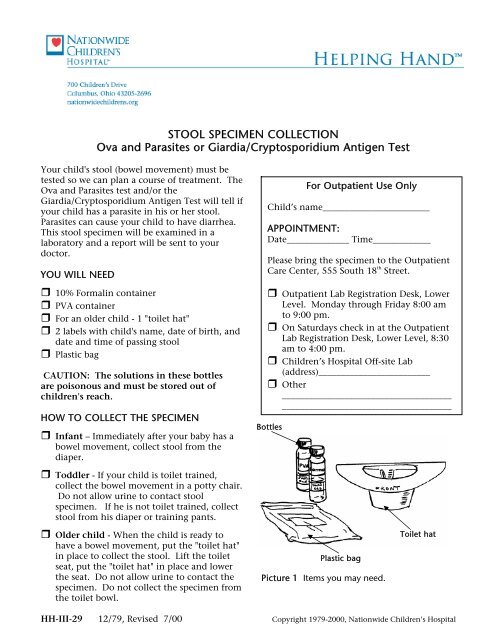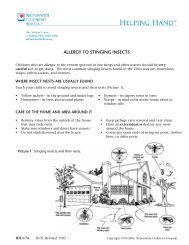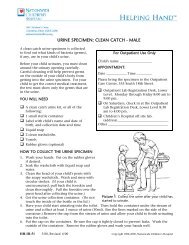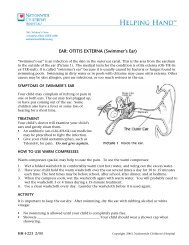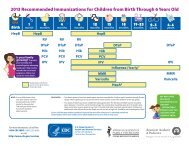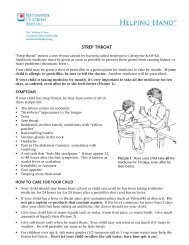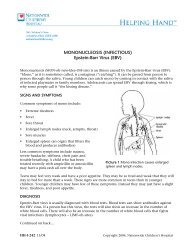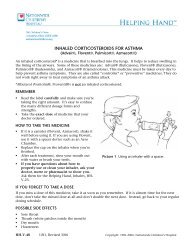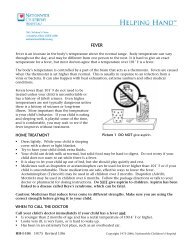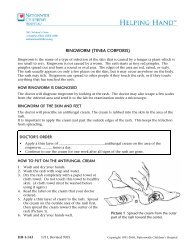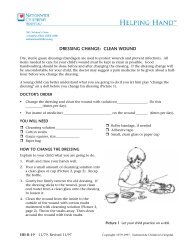STOOL SPECIMEN COLLECTION Ova and Parasites or Giardia ...
STOOL SPECIMEN COLLECTION Ova and Parasites or Giardia ...
STOOL SPECIMEN COLLECTION Ova and Parasites or Giardia ...
Create successful ePaper yourself
Turn your PDF publications into a flip-book with our unique Google optimized e-Paper software.
<strong>STOOL</strong> <strong>SPECIMEN</strong> <strong>COLLECTION</strong><br />
<strong>Ova</strong> <strong>and</strong> <strong>Parasites</strong> <strong>or</strong> <strong>Giardia</strong>/Cryptosp<strong>or</strong>idium Antigen Test<br />
Your child's stool (bowel movement) must be<br />
tested so we can plan a course of treatment. The<br />
<strong>Ova</strong> <strong>and</strong> <strong>Parasites</strong> test <strong>and</strong>/<strong>or</strong> the<br />
<strong>Giardia</strong>/Cryptosp<strong>or</strong>idium Antigen Test will tell if<br />
your child has a parasite in his <strong>or</strong> her stool.<br />
<strong>Parasites</strong> can cause your child to have diarrhea.<br />
This stool specimen will be examined in a<br />
lab<strong>or</strong>at<strong>or</strong>y <strong>and</strong> a rep<strong>or</strong>t will be sent to your<br />
doct<strong>or</strong>.<br />
YOU WILL NEED<br />
10% F<strong>or</strong>malin container<br />
PVA container<br />
F<strong>or</strong> an older child - 1 "toilet hat"<br />
2 labels with child's name, date of birth, <strong>and</strong><br />
date <strong>and</strong> time of passing stool<br />
Plastic bag<br />
CAUTION: The solutions in these bottles<br />
are poisonous <strong>and</strong> must be st<strong>or</strong>ed out of<br />
children's reach.<br />
HOW TO COLLECT THE <strong>SPECIMEN</strong><br />
Infant – Immediately after your baby has a<br />
bowel movement, collect stool from the<br />
diaper.<br />
F<strong>or</strong> Outpatient Use Only<br />
Child’s name________________________<br />
APPOINTMENT:<br />
Date______________ Time_____________<br />
Please bring the specimen to the Outpatient<br />
Care Center, 555 South 18 th Street.<br />
Outpatient Lab Registration Desk, Lower<br />
Level. Monday through Friday 8:00 am<br />
to 9:00 pm.<br />
On Saturdays check in at the Outpatient<br />
Lab Registration Desk, Lower Level, 8:30<br />
am to 4:00 pm.<br />
Children’s Hospital Off-site Lab<br />
(address)_________________________<br />
Other<br />
______________________________________<br />
______________________________________<br />
Bottles<br />
Toddler - If your child is toilet trained,<br />
collect the bowel movement in a potty chair.<br />
Do not allow urine to contact stool<br />
specimen. If he is not toilet trained, collect<br />
stool from his diaper <strong>or</strong> training pants.<br />
Older child - When the child is ready to<br />
have a bowel movement, put the "toilet hat"<br />
in place to collect the stool. Lift the toilet<br />
seat, put the "toilet hat" in place <strong>and</strong> lower<br />
the seat. Do not allow urine to contact the<br />
specimen. Do not collect the specimen from<br />
the toilet bowl.<br />
Plastic bag<br />
Picture 1 Items you may need.<br />
Toilet hat<br />
HH-III-29 12/79, Revised 7/00 Copyright 1979-2000, Nationwide Children’s Hospital
Stool Specimen Collection - <strong>Ova</strong> & <strong>Parasites</strong> <strong>or</strong> <strong>Giardia</strong>/Cryptosp<strong>or</strong>idium Antigen Test Page 2 of 2<br />
HOW TO PREPARE THE <strong>SPECIMEN</strong><br />
1. Use the scoop on the<br />
container caps to place stool<br />
in the containers. Keep<br />
adding stool until the fluid<br />
level in the bottle reaches, <strong>or</strong><br />
is higher than the collection<br />
line on the containers. If<br />
there is not much stool, put<br />
what you have in the<br />
containers.<br />
2. Make sure that the stool<br />
specimen in each container is<br />
in the solution <strong>and</strong> not on<br />
the sides of the container.<br />
Put caps tightly on the<br />
containers. Shake them to<br />
mix. If stool is solid use the<br />
collection scoop to mix the<br />
sample. Stool should be<br />
placed in the containers<br />
immediately after collection.<br />
3. Wash your h<strong>and</strong>s well.<br />
Write your child's name,<br />
date of birth, <strong>and</strong> the date<br />
<strong>and</strong> time of the bowel<br />
movement on the<br />
collection containers. Place<br />
containers in a plastic bag.<br />
OTHER INFORMATION<br />
• Specimen should be kept at room temperature <strong>and</strong> taken to the lab within 48 hours.<br />
• Collect the specimens even if your child has diarrhea; collect any blood <strong>or</strong> mucus if present.<br />
• If you are collecting specimens f<strong>or</strong> m<strong>or</strong>e than one child, make sure each of the containers is<br />
labeled with the right child's name <strong>and</strong> date of birth.<br />
• You will be given the test results at your next clinic visit, <strong>or</strong> you may call your doct<strong>or</strong>'s office in 3<br />
days to get the results of the test.<br />
• If the test is positive (meaning a parasite was found), your doct<strong>or</strong> will talk with you about the<br />
treatment needed.<br />
WARNING: Liquid in containers is poisonous. Keep out of reach of children. If swallowed, dilute<br />
by giving 2 to 4 glasses of water to drink. Call the Central Ohio Poison Center (1-800-682-7625)<br />
immediately. Save the bottles. The label inf<strong>or</strong>mation will be helpful f<strong>or</strong> treatment.<br />
If you have any questions, be sure to ask your doct<strong>or</strong> <strong>or</strong> nurse.


